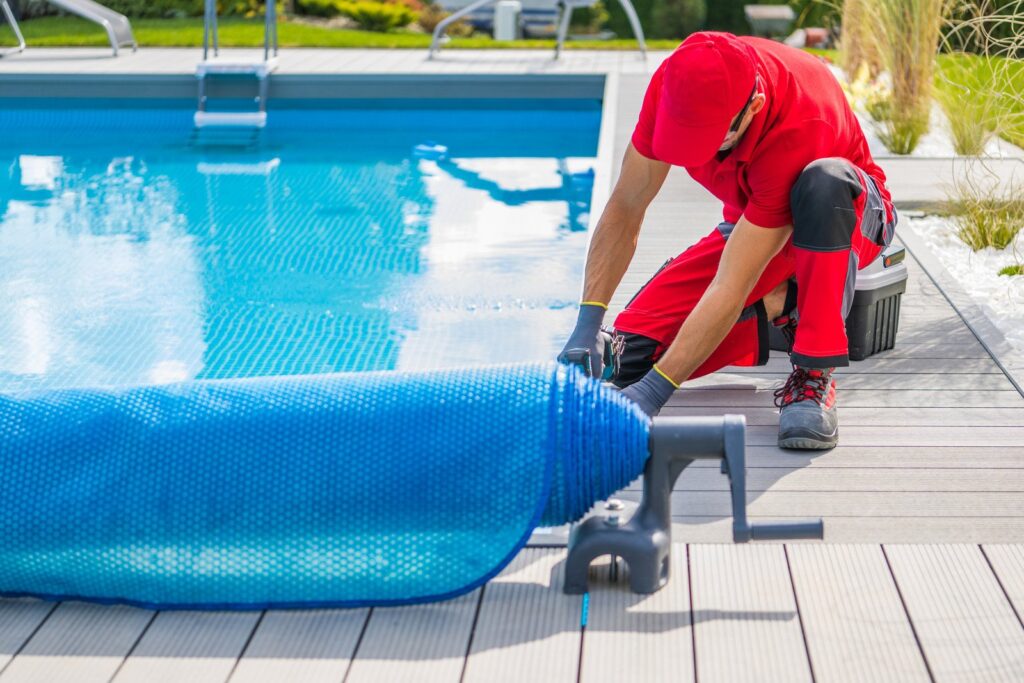When considering a swimming pool installation, you need to approach the project methodically. Start by evaluating your backyard space and determining a realistic budget. It’s vital to understand the various pool types available and the unique features that could improve your experience. As you progress, you’ll encounter important steps like obtaining permits and selecting a qualified contractor. Let’s explore these stages to guarantee your pool installation goes smoothly and meets your expectations.

Key Takeaways
- Assess your backyard space for layout, soil quality, and utility placement to ensure adequate room for the pool installation.
- Set a budget that includes materials, labor, and permits, allowing for contingencies of 10-20% for unexpected costs.
- Obtain necessary permits by researching local requirements and submitting applications along with detailed site plans.
- Choose a suitable pool location considering sunlight exposure, privacy, and access to utilities before beginning excavation.
- Install essential equipment like filtration systems and safety features, and establish a maintenance schedule for ongoing upkeep.
Assessing Your Backyard Space
Before you plunge into the pool installation process, it’s essential to evaluate your backyard space carefully.
Start by examining your backyard layout; consider the size, shape, and existing structures like trees or patios. These elements will impact where you can install your pool.
Next, investigate the soil quality. Test the soil for drainage and stability, as poor soil may require additional reinforcement or excavation. If your soil retains too much water, it could lead to structural issues down the line.
Additionally, check for any underground utilities, as they can complicate installation.
Setting a Budget and Timeline
When setting a budget for your swimming pool installation, you’ll need to determine total costs, including materials, labor, and permits.
Additionally, estimating a realistic timeframe for completion is essential to avoid delays.
Don’t forget to plan for contingencies, as unexpected expenses can arise during the project.
Determine Total Costs
Setting a budget and timeline for your swimming pool installation involves careful consideration of various factors, including materials, labor, and additional features.
Start by creating a detailed cost breakdown that includes expenses for excavation, pool structure, liner, filtration systems, and decking. Don’t forget to account for permits and any landscaping needed afterward.
Investigate financing options, such as personal loans or home equity lines of credit, to help manage your budget effectively. Be realistic about your financial limits and prioritize features that matter most to you.
Estimate Timeframe
Once you’ve established your budget, the next step is to estimate the timeframe for your swimming pool installation.
Typically, the pool installation duration can range from a few weeks to several months, depending on factors like the pool type, size, and site conditions.
Start by consulting with your contractor to create a detailed construction timeline. This should include key milestones such as excavation, plumbing, electrical work, and finishing touches.
Keep in mind that weather conditions and permitting processes can influence your timeline.
It’s vital to maintain open communication with your contractor to guarantee that any delays are addressed promptly.
Plan for Contingencies
As you develop your budget and timeline for the swimming pool installation, it’s essential to plan for contingencies that may arise during the process.
Allocate an additional 10-20% of your budget for unexpected costs, such as equipment failures or design changes.
Create emergency plans to address potential issues, like inclement weather causing unexpected delays.
Set realistic timelines, factoring in these variables; aim for flexibility to accommodate disruptions.
For instance, if you anticipate a two-week installation, consider extending it to three weeks.
This buffer allows you to manage unforeseen circumstances without stress.
Researching Pool Types and Features
When researching pool types, you’ll need to weigh the pros and cons of inground versus above-ground options.
Each type offers distinct advantages, such as durability and ease of installation.
Additionally, understanding essential features like filtration systems, heating options, and safety measures will guarantee you make an informed choice that suits your needs.
Inground vs. Above Ground
Choosing between inground and above ground pools is a critical decision that can profoundly impact your backyard experience.
Inground pools offer installation benefits such as customized shapes and sizes, enhancing aesthetics and property value. They typically require more extensive excavation and construction, leading to a permanent structure.
Conversely, above ground pools are easier and quicker to install, often requiring less site preparation and lower initial costs.
However, maintenance differences are significant. Inground pools generally demand more upkeep due to complex systems and larger surface areas, while above ground pools may require less chemical balancing and simpler cleaning routines.
Ultimately, your choice should align with your budget, space, and long-term maintenance commitment.
Essential Pool Features
After settling on the type of pool that best fits your needs, the next step involves examining the key features that can enhance your swimming experience.
Consider incorporating water features such as fountains or waterfalls, which not only improve aesthetics but also provide soothing sounds that elevate relaxation.
Additionally, look into various lighting options, like LED lights or fiber optics, to create a captivating ambiance for evening swims and gatherings. These options can be integrated into the pool structure or surrounding landscape.
Don’t forget to evaluate safety features, such as non-slip surfaces and pool covers, to guarantee a secure environment for all users.
Obtaining Necessary Permits
Before you plunge into the installation of your swimming pool, securing the necessary permits is vital to guarantee compliance with local regulations.
Begin by researching your area’s permit requirements, as these can vary greatly by municipality. Commonly, you’ll need to submit an application to your local building department. This application process often includes providing details like pool dimensions, depth, and proximity to property lines.
Be prepared to present site plans and possibly pay associated fees. Additionally, some jurisdictions may require inspections during and after installation to verify adherence to safety standards.
Failing to obtain the required permits can lead to costly fines or forced removal of your pool, so it’s critical to handle this step diligently.
Choosing a Pool Contractor
How do you find the right pool contractor for your installation project? Start by evaluating contractor qualifications, including certifications, licenses, and insurance. A qualified contractor will have a solid track record and experience with your specific pool type.
Check for affiliations with professional organizations, which indicate a commitment to industry standards.
Next, gather client testimonials to gauge previous customers’ satisfaction. Reach out to references and ask about their installation experience, communication, and post-installation support. You can also search online reviews for additional insights.
Lastly, get multiple quotes to compare pricing and services. This gives you a clearer picture of what to expect.
Choosing the right contractor guarantees your pool installation goes smoothly and meets your expectations.
Preparing the Site
While you might be enthusiastic to start your pool installation, preparing the site is essential for a successful project.
Begin with a thorough site assessment to evaluate the chosen location. Check for any underground utilities, trees, or structures that could interfere with the installation.
Next, conduct a soil analysis to determine the soil type and its load-bearing capacity. This analysis will guide you in selecting the appropriate pool structure and installation method. If the soil is sandy or unstable, consider reinforcing it to prevent shifting.
Additionally, make certain proper drainage to avoid water accumulation around the pool. Taking these steps will help you establish a solid foundation for your pool, leading to a smoother installation process and long-term stability.
Installing the Pool Structure
Once you’ve selected the ideal pool location, you’ll need to focus on excavation and base preparation.
Accurate measurements and leveling are essential to guarantee a stable structure that meets local regulations.
Following these steps meticulously will set a solid foundation for your pool installation.
Choosing Pool Location
Choosing the right location for your swimming pool is essential to guarantee both functionality and aesthetic appeal.
First, consider sun exposure; a spot that receives ample sunlight not only keeps the water warm but also improves your swimming experience. Ideally, position the pool to maximize sunlight throughout the day, avoiding shaded areas from trees or structures.
Next, address privacy concerns. Select a location that provides sufficient screening from neighbors or public view—this could involve strategic landscaping or positioning away from sightlines.
Additionally, confirm easy access to utilities, such as water and electricity, without compromising aesthetics.
Excavation and Base Preparation
With the location finalized, the next step involves excavation and base preparation for your swimming pool.
Start by marking the pool’s outline, ensuring it adheres to local regulations. Next, excavate to the required depth, considering the pool’s design and features.
During excavation, assess soil stability; loose or unstable soil may necessitate reinforcement or additional drainage solutions. Proper drainage considerations are essential to prevent water accumulation and preserve the pool’s integrity.
After excavation, create a level base using compacted gravel or sand to support the pool structure. This base not only provides stability but also aids in water drainage, ensuring a long-lasting installation.
Verify the levelness and compactness before proceeding to the next phase of your swimming pool installation.
Adding Pool Equipment and Accessories
As you prepare to improve your swimming pool experience, incorporating the right equipment and accessories is crucial for functionality and enjoyment.
Start with a reliable filtration system to guarantee clean water and reduce pool maintenance efforts. Consider energy-efficient pumps that can greatly lower your electricity bills while maintaining ideal circulation.
Adding a heater extends your swimming season, making your pool enjoyable year-round. For added convenience, install automated cleaning devices to simplify maintenance tasks.
Don’t forget safety essentials like pool covers and alarms to protect your family.
Finally, elevate your pool ambiance with lighting and water features, creating a more inviting atmosphere.
Landscaping Around the Pool
While you design the area around your pool, thoughtful landscaping can improve both aesthetics and functionality.
Start by selecting poolside plants that thrive in your climate and require minimal maintenance, such as ornamental grasses or tropical shrubs. These plants can provide shade, privacy, and a natural barrier against debris.
Next, consider incorporating decorative stones to create defined pathways and seating areas. Use materials like river rocks or pebbles, which can boost drainage and prevent soil erosion. Additionally, position larger stones strategically to create visual interest and texture.
Finally, make sure that your landscaping includes adequate lighting for safety and ambiance, making your pool area enjoyable both day and night.
Final Inspection and Maintenance Tips
Before you plunge into enjoying your new pool, conducting a thorough final inspection is essential to confirm everything’s in proper order. Check all equipment, including pumps, filters, and heaters, guaranteeing they operate efficiently.
Inspect the pool surface for any cracks or rough spots, and verify that all safety features, like pool covers and alarms, are installed correctly. Verify the water chemistry, adjusting pH and chlorine levels as needed.
Next, establish a maintenance schedule to keep your pool in peak condition. Regularly clean filters, check water levels, and inspect for debris.
Plan for seasonal maintenance, including winterizing your pool. By adhering to a diligent maintenance schedule, you can confirm your pool remains a safe and enjoyable oasis for years to come.
Frequently Asked Questions
What Are Common Mistakes to Avoid During Pool Installation?
When installing a pool, avoid choosing the wrong pool size and neglecting proper site preparation. Guarantee accurate measurements and clear the area of debris to prevent complications during installation and future maintenance issues.
How Can I Enhance Pool Safety for Children and Pets?
To improve pool safety for children and pets, install child safety fences and secure pet barriers. Regularly check for gaps and make certain gates self-close. Educate kids about water safety and supervise them at all times.
What Type of Lighting Is Best for Around the Pool?
For pool lighting, consider LED options for energy efficiency and durability. Solar lights can also improve ambiance and safety, providing illumination without wiring. Choose fixtures that withstand moisture and offer adjustable brightness for ideal visibility.
Are There Eco-Friendly Pool Options Available?
Yes, you’ve got eco-friendly pool options! Consider using sustainable materials like recycled glass tiles and energy-efficient systems such as solar heating and variable-speed pumps. These choices reduce environmental impact while maintaining pool functionality and aesthetics.
How Do I Winterize My Pool After Installation?
To winterize your pool, first balance the chemicals. Then, drain water below the skimmer, clean the pool, and install a pool cover securely. This protects against debris and maintains your pool’s integrity during the winter months.
Conclusion
Successfully installing a swimming pool requires careful planning and execution. By evaluating your space, setting a realistic budget, and choosing the right contractor, you can create a backyard oasis customized to your needs. Pay attention to details during the installation process, ensuring all equipment is properly added and the area is landscaped. Finally, conduct a thorough inspection to guarantee safety and functionality. With these steps, you’ll enjoy your new pool for years to come.

